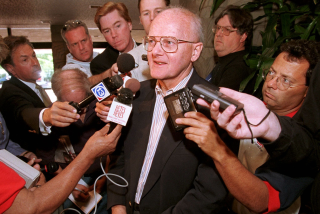Security Conference Has Some Interesting Antecedents : History: The Congress of Vienna, Treaty of Versailles, the League of Nations all had a hand in shaping Europe. Now, the CSCE promises to lead it in a new direction.
- Share via
LONDON — The 34-nation summit meeting of the Conference on Security and Cooperation in Europe (CSCE) in Paris is designed to mark the end of the Cold War and to chart a new future for Europe.
Its broad sweep has evoked images of other major international conferences that shaped the Europe of the 20th Century.
Notable among these was the Congress of Vienna, which redrew the map of Europe in the aftermath of the Napoleonic Wars. That assembly, which met in the Austrian capital in 1814-15, agreed to boundaries that lasted more than 40 years and had even more far-reaching significance.
The congress condemned the slave trade, recommended extension of rights granted to Jews and formally established a system of international diplomacy. But in reorganizing Europe, it also strengthened Prussia at the expense of France. And Prussia, later buoyed by the victorious war against France in 1870, became the dominant Continental power. That, in turn, led indirectly to World War I.
The end of that great war resulted in another historic meeting on Europe’s future, the Paris Peace Conference in 1919, dominated by President Woodrow Wilson, French Prime Minister Georges Clemenceau and his British counterpart, David Lloyd George.
The treaty was signed outside Paris at Versailles, and the severity of its peace terms--loss of territory, acceptance of “war guilt,” crippling monetary reparations and other humiliations--shocked and embittered a defeated Germany.
The Treaty of Versailles included a Covenant of the League of Nations, under which members guaranteed each other’s territorial integrity. But the U.S. Senate refused to ratify the treaty and the United States never became a member of the League of Nations, which proved to be ineffective in preventing or reversing aggression.
As postwar tensions mounted in Europe, a series of international conferences were held in 1925 in Locarno, Switzerland, and produced treaties confirming existing agreements. The process was viewed as a resounding success until the rise of Adolf Hitler.
The late 1920s euphoria was enhanced by the 1928 Kellogg-Briand Pact (named for Secretary of State Frank B. Kellogg and French Foreign Minister Aristide Briand), which was signed in Paris by 15 powers, with an additional 56 nations adhering to the principles later. It formally renounced war as an instrument of national policy.
In 1932-34, 60 nations met in Geneva under the auspices of the League of Nations in a major disarmament conference, which failed, partly because of Hitler, who came to power in January, 1933. Germany withdrew from the conference in October, 1933.
The outbreak of World War II led to several major conferences, perhaps the most important of which was the 1944 Dumbarton Oaks Conference near Washington to discuss the proposed United Nations organization. The results of the negotiations were forwarded to a 50-nation conference in San Francisco in 1945.
There, the U.N. Charter was drafted. It was later ratified at the first meeting of the U.N. General Assembly in London on Oct. 24, 1945.
Meanwhile, the Potsdam Conference in July-August, 1945, the last of the wartime meetings, was held outside Berlin to discuss Allied control of Germany and postwar borders. During the conference, British Prime Minister Winston Churchill was defeated in a national election and replaced by the Labor Party’s Clement Attlee.
In 1948, faced with the threat of possible Soviet aggression, five European nations signed the Treaty of Brussels in the Belgian capital. That served as the template for the North Atlantic Treaty Organization, which was completed in Washington in 1949.
(The term “summit conference” was coined by Churchill in 1950 when he called for a “parley at the summit” with East-West leaders.)
In 1957, the Treaty of Rome signed by representatives of six European nations established the European Economic Community, otherwise known as the Common Market, which was eventually to abolish internal barriers between the countries. The EC, as it is now called, has grown to 12 members.
The first CSCE meetings began in 1972. Thirty-three European nations plus the United States and Canada attended. (The total dropped by one when East and West Germany merged in October.) The negotiations, lasting three years, resulted in broad agreements on European security, human rights and economic issues that were codified in a document called the Final Act, signed in Helsinki, Finland, in 1975.
This provided for conferences to monitor implementation of the agreements which were held in Belgrade, in 1977; Madrid in 1980; and since 1986 in Vienna, where most of the new set of agreements scheduled to be signed at the Paris summit were hammered out in prolonged negotiating sessions.
More to Read
Sign up for Essential California
The most important California stories and recommendations in your inbox every morning.
You may occasionally receive promotional content from the Los Angeles Times.













